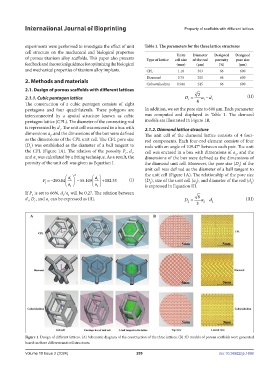Page 217 - IJB-10-2
P. 217
International Journal of Bioprinting Property of scaffolds with different lattices
experiments were performed to investigate the effect of unit Table 1. The parameters for the three lattice structures
cell structure on the mechanical and biological properties Unite Diameter Designed Designed
of porous titanium alloy scaffolds. This paper also presents Type of lattice cell size of the rod porosity pore size
feedback and theoretical guidance for optimizing the biological (mm) (μm) (%) (μm)
and mechanical properties of titanium alloy implants. CPL 1.18 363 66 600
Diamond 0.76 200 66 600
2. Methods and materials Cuboctahedron 0.946 245 66 600
2.1. Design of porous scaffolds with different lattices 3
2.1.1. Cubic pentagon lattice D 4 2 a d 1 (II)
1
1
The construction of a cubic pentagon consists of eight
pentagons and four quadrilaterals. These polygons are In addition, we set the pore size to 600 μm. Each parameter
interconnected by a spatial structure known as cubic was computed and displayed in Table 1. The demand
pentagon lattice (CPL). The diameter of the connecting rod models are illustrated in Figure 1B.
is represented by d . The unit cell was encased in a box with 2.1.2. Diamond lattice structure
1
dimensions a , and the dimensions of the box were defined The unit cell of the diamond lattice consists of 4 four-
1
as the dimensions of the CPL unit cell. The CPL pore size rod components. Each four-rod element consists of four
(D ) was established as the diameter of a ball tangent to rods with an angle of 109.47° between each pair. The unit
1
the CPL (Figure 1A). The relation of the porosity P , d , cell was encased in a box with dimensions of a , and the
1
1
2
and a was calculated by a fitting technique. As a result, the dimensions of the box were defined as the dimensions of
1
porosity of the unit cell was given as Equation I. the diamond unit cell. Moreover, the pore size (D ) of the
2
unit cell was defined as the diameter of a ball tangent to
d 2 d the unit cell (Figure 1A). The relationship of the pore size
P 290 84 1 55 109 1 102 33 (I) (D ), size of the unit cell (a ), and diameter of the rod (d )
.
.
.
1
2
a 1 a 1 is expressed in Equation III. 2 2
If P is set to 66%, d /a will be 0.27. The relation between
1
1
1
d , D , and a can be expressed as (II). D 6 a d (III)
1
1
1
2
3 2 2
Figure 1. Design of different lattices. (A) Schematic diagram of the construction of the three lattices. (B) 3D models of porous scaffolds were generated
based on three different unit cell structures.
Volume 10 Issue 2 (2024) 209 doi: 10.36922/ijb.1698

